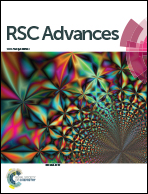Formononetin in Radix Hedysari extract-mediated green synthesis of gold nanoparticles for colorimetric detection of ferrous ions in tap water†
Abstract
This study linked natural plant materials and nanomaterials; reporting an environmentally friendly, non-toxic and efficient method for the green synthesis of gold nanoparticles (AuNPs) using an ethyl acetate extract of Radix Hedysari (EAR). The components of the extract were identified using HPLC and it was found that formononetin accounted for more than 90% of the total contents. We predicted that formononetin in EAR plays a crucial role in green synthesis. Thus, formononetin was used as a standard reductant to synthesize AuNPs, and the result confirmed our prediction. The synthetic mechanism was also discussed in detail in the article. Moreover, EAR–AuNPs realized the sensitive and selective colorimetric detection of ferrous ions (Fe2+) among other metal ions, and were applied to spiked tap water with a low detection limit of 1.5 μM in a wide range from 10 μM to 500 μM. EAR–AuNPs were green synthesized using Radix Hedysari extract for the first time and were successfully applied in real sample detection.



 Please wait while we load your content...
Please wait while we load your content...